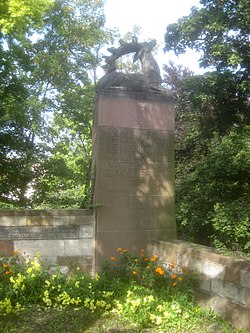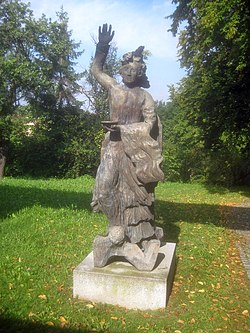Gaisburg cemetery
The Stuttgart cemetery Gaisburg is located in the Gaisburg district in the Stuttgart-East district . It was laid out in 1836 and expanded to its present total area in 1880 and 1971. The cemetery is one of the small Stuttgart cemeteries. Its area covers about 1 hectare and is divided into sections 1-13 with about 1700 grave sites. On the cemetery area there is a celebration hall, the old morgue, a memorial and the statue “Easter Angel”.
The cemetery extends between Schurwaldstrasse with the Herz Jesu Church in the north and Hornbergstrasse in the south and between Krauchenweg in the east and a section of Pflasteräckerstrasse in the west. The mostly level cemetery is at a height of about 270 meters above sea level , the celebration hall is at the highest point of the cemetery at a height of about 275 meters.
Celebration hall
The new celebration hall (or funeral hall) was built in 2002 according to the plans of the Stuttgart architects Dasch, Zürn and von Scholley to remedy the shortage of space in the small old morgue . The hall can be reached directly via the cemetery entrance Hornbergstraße 140 on the corner of Pflasteräckerstraße.
The tall building rises on an almost square base of around 200 square meters. The interior consists of the one-storey, hall-like celebration room with over 70 seats as well as the laying out, lounge and function rooms, which are located on two floors on the side of the celebration room. Almost closed wall panels shield the rooms from Hornbergstrasse and Pflasteräckerstrasse. Ceiling-high glazing opens the party room on the other two sides to the cemetery, creating flowing transitions between inside and outside.
The flat roof of the celebration hall protrudes 8 meters over the building on two sides as an airy canopy. Four large square openings in the canopy add light to the interior. On the entrance side, the celebration room can be opened across its entire width to the forecourt, so that there is also space for a larger mourning community. To the right of the entrance to the celebration hall is the statue of the Easter angel . With his arm raised in blessing, he turns to the entrance from which the funeral processions emerge.
Old morgue
The cemetery entrance on Schurwaldstrasse leads to the simple old morgue, which is located in the middle of the cemetery between departments 3 and 7. The small building with a floor area of around 50 square meters consists of a narrow, chapel-like structure with a gable roof and a lower pentagonal apse extension with a tent roof. There is also a public toilet in the annex.
memorial
The memorial for the victims of the two world wars was erected in 1928 at the height of the slope that runs parallel to Schurwaldstrasse and the Herz Jesu Church. A tall sandstone pedestal that forms the corner of the cemetery wall is crowned by the figure of a dying stag.
The sculpture is the work of the sculptor Jakob Brüllmann , who created a number of other war memorials in and around Stuttgart and the Reformation monument at the Hospitalhof in Stuttgart. The stag lies on the pedestal and in pain stretches its head back so that its mighty ten-end antlers touch the trunk with the tips. On the street side, the pedestal bears the reliefs of a sword and a steel helmet.
The memorial was erected in the years after the First World War. The following inscription is carved on the broad side of the pedestal:
- The memory of those loyal to them who gave their lives for their country.
Dedicated by citizens of Gaisburg.
The cemetery wall used to have a list of the names of the Gaisburgs who died in World War I. After the Second World War, a relief plaque with the following inscription was added instead of the list on the cemetery wall:
- In memory of the victims of two world wars and the victims of the tyranny - the living as a warning.
Easter angel
To the right of the main entrance of the celebration hall stands the bronze sculpture “Osterengel”, a work by the sculptor Siegfried Haas (1921–2011) from 2003 on a low stone plinth.
According to the Gospel of Matthew, after Christ's resurrection, an angel came to his tomb, rolled the stone in front of it, showed Mary and Mary Magdalene the empty tomb and said:
- “Do not be afraid! I know that you are looking for Jesus who was crucified. He is not here; he is risen as he said. "
The 2.50 meter tall male figure of the Easter angel hovers over a dwarf man who has risen from the grave and is lying on his back with a skull and bulky limbs, which he stretches out. The angel leans against the tall, thick tombstone of the dead man, which weighs down on his body and legs. As a personification of victory over the powers of death, the Easter angel raises his right hand as a sign of blessing, with his left he offers a bowl of anointing oil.
Graves
| → Column legend and sorting | ||||||||||
| Legend | ||||||||||
|
||||||||||
| Sorting | ||||||||||
| Illustration | # | P | K | dig | * | † | object |
|---|---|---|---|---|---|---|---|
|
|
K | Amthor Hotz. | Fluted column with attached urn. | ||||
|
|
K | Artur Boehme. | 1899 | 1982 | Tomb with the sculpture of a hat as an attachment. | ||
|
|
K | Tanning. | Standing propeller made of marble. | ||||
|
|
K | Caserion Della Penna. | 1937 | 1995 | Round, two-part tomb with a relief of a saint holding a man to her chest. | ||
|
|
K | Wilhelm Foell. | 1851 | 1894 | Relief of a standing mourner. | ||
|
|
K | Otto Karl. | 1921 | 2001 | Three-part sandstone tomb with a white cross and gold inscriptions. | ||
|
|
K | Ulla Karle. | 1957 | 2002 | Drawing of a mountain landscape with a footbridge over a mountain stream, with a jumping horse and the bright sun under threatening clouds. | ||
|
|
K | Otto Schneider, parish priest in the Herz Jesu Church. | 1927 | 1986 | Medallion with cross made of different colored glasses. | ||
|
|
K | Eugene's son. | 1924 | 1988 | Tomb in the form of a tower in the game of chess. Crack drawing on the left: Masons' guild mark from compass, angle triangle, plumb line (perhaps also Freemason's mark). Plan drawing on the right: outlines of 8 chess pieces. | ||
|
|
K | Ellen Vollmer. | 1951 | 2014 | Roughly worked, triangular tombstone with a kneeling mourner growing out of the side. |
literature
- Ulrich Gohl: In public space. Works of art and monuments in the east of Stuttgart. Stuttgart 2010.
- Mammut-Verlag (publisher and editor): Stuttgart, Der Friedhofswegweiser. Stuttgart 2011, page 43 (available free of charge, for example from the information desk in Stuttgart City Hall).
Web links
- Gaisburg Cemetery on the website of the City of Stuttgart .
- To the new celebration hall:
- Website from Baunetz.de .
- Website of the architects Dasch Zürn .
Footnotes
- ↑ #Mammut 2011 - The departments are not marked with number plates or number plates as is usual.
- ↑ #Gohl 2010 , page 28.
- ↑ Gospel according to Matthew, Chapter 28 .
- ↑ #Gohl 2010 , page 69.
Coordinates: 48 ° 46 ′ 51.1 ″ N , 9 ° 12 ′ 48.2 ″ E


















